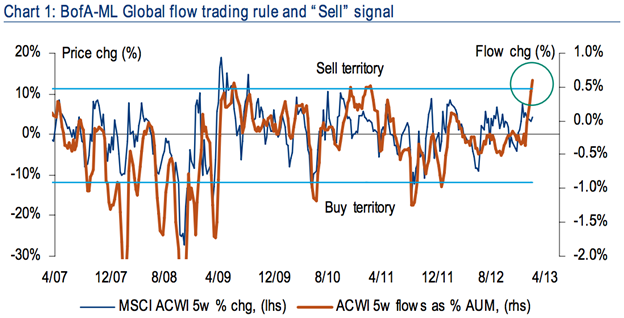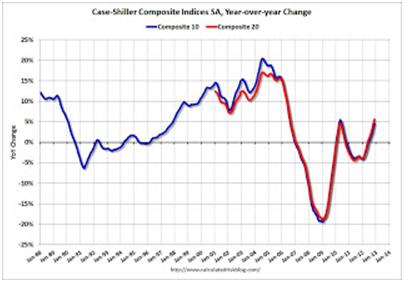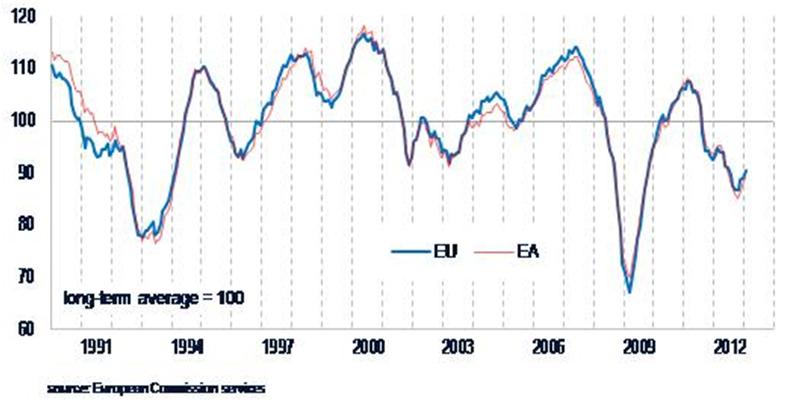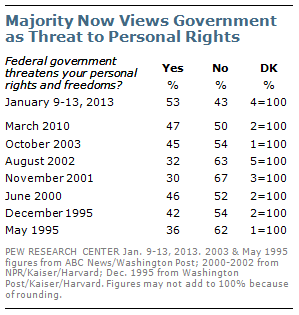Whenever there is a big market move – in either direction – the question arises: Is it too much, too soon? I predicted that this week's focus would be on whether it was time for the individual investor to return to stocks. That was a good forecast ---for about two days!
The media tilt ensued very quickly. Since consumers of financial media are looking for actionable advice, the sources have a tilt toward trading. We all know that markets do not move in a straight line, so any significant move brings out those planning to "sell the rips and buy the dips."
Here are three interesting perspectives:
Correction Ahead
Some of the calls for a correction even emphasize the recent shift in fund flows, reflecting the change in attitude by some individual investors. Here is an example from BofA Merrill Lynch strategist Michael Hartnett, reported by Matthew Boesler of Business Insider.
For Hartnett, this implies a possible correction of 5% over a month or so. The article cites similar forecasts from other Street analysts.
Probable New Highs
Charles Kirk has, as usual, a balanced viewpoint in his weekly chart show. While noting the potential for a correction, Charles expects a test of the old highs first, possibly followed by a completion of the current bullish chart setup. My brief summary is but a shadow of what you get from the weekly chart show. (The Kirk Report requires a small membership charge, and is well worth it).
A Longer View Taking a longer view, Josh Brown has an excellent post, Ray Dalio Schools You on the Great Rotation Debate. This must-read article explains why the current inflows to stock funds are not merely from bonds and not just from individual investors. Josh has taken the key points from a Dalio interview, helping his readers to see what is really important.
Naturally, I have my own thoughts on this topic and I'll cover those in the conclusion. First, let us do our regular update of last week's news and data.
Background on "Weighing the Week Ahead"
There are many good lists of upcoming events. One source I especially like is the weekly post from the WSJ's Market Beat blog. There is a nice combination of data, speeches, and other events.
In contrast, I highlight a smaller group of events. My theme is an expert guess about what we will be watching on TV and reading in the mainstream media. It is a focus on what I think is important for my trading and client portfolios.
This is unlike my other articles, where I develop a focused, logical argument with supporting data on a single theme. Here I am simply sharing my conclusions. Sometimes these are topics that I have already written about, and others are on my agenda. I am putting the news in context.
Readers often disagree with my conclusions. Do not be bashful. Join in and comment about what we should expect in the days ahead. This weekly piece emphasizes my opinions about what is really important and how to put the news in context. I have had great success with my approach, but feel free to disagree. That is what makes a market!
Last Week's Data
Each week I break down events into good and bad. Often there is "ugly" and on rare occasion something really good. My working definition of "good" has two components:
- The news is market-friendly. Our personal policy preferences are not relevant for this test. And especially -- no politics.
- It is better than expectations.
This was another good week, both for data and for earnings. The most important reports were positive.
- Year-over-year growth in forward earnings – confirming the trough in Q3 of 2012. Even CNBC got on this theme last week, belatedly following the on-target commentary from Brian Gilmartin. Brian notes that the estimates are still declining a bit, but reflect an increase of nearly 6% over last year. Read the full report for plenty of detail and interpretation that you will not see elsewhere.
- Q4 earnings reports continue to beat on both the top and bottom lines. Bespoke has their typically fine charts, including this one on revenue:

- China is looking better. Or is it? We have been following the dueling PMI indicators for months, with Markit's version usually more pessimistic than the "official" version. Now this has reversed. I am scoring this in favor of Markit, but there is a great analysis by Kate Mackenzie at FT Alphaville and also good commentary at GEI.
- Employment continues to improve, especially when you consider the final revised data. See Phil Izzo's excellent summary of economic opinion. In my monthly preview I explained why you need to look at the final results from state employment data, not just the preliminary estimates. We all know that employment gains trail what is needed for a robust recovery, but there is progress.
- The ISM index notched a significant upside surprise, with solid contributions from the various subcategories. The 53.1 reading is consistent with real GDP growth of 3.4%, according to their research.
- Housing data showed another week of improvement including both construction and Case-Shiller home prices. See Calculated Risk for both themes. The Case-Shiller approach has a three-month average that is not seasonally adjusted. The Calculated Risk chart makes it easier to see the current trend.

The Bad
There was plenty of data, and some of it was negative.
- Initial jobless claims rebounded to 368K after two weeks of dramatic improvement. It is a challenging time for seasonal adjustments.
- Conference Board consumer confidence disappointed at 58.6, down from 66.7 last month. This corresponded to the mid-month decline in the Michigan index. Payroll tax effects?
- The spike in personal income was deceptive according to Dwaine Van Vuuren's analysis. He expects January to decline, reflecting the pulling forward of income because of fiscal cliff fears. Dwaine pays special attention to this indicator since it is part of his NBER recession model (details here).
- Gasoline prices moved higher, continuing the recent trend (via GEI).

Europe's problems continue
. FT.com notes the increase in European business confidence. The Bonddad Blog says that Europe is "Still a Mess" and provides a chart as evidence: 
- Employees were surprised by the payroll tax increase. Anecdotal evidence from Tim Duy.
- Q4 GDP had a negative print of -0.1% in the advance estimate. Doug Short and Steven Hansen of Global Economic Intersection call this a "nasty surprise" and provide plenty of charts and data to show some historical perspective. Many felt that the data included a convergence of "one-off" effects and the market shrugged off the news. See (MarketWatch for a summary of points and Econbrowser for Prof. Hamilton's take and more links). Scott Grannis shows why the current economic growth is not enough.

The Ugly
The government threatens our personal rights according to a majority polled by Pew Research. This is a dramatic increase from a decade ago. Most people do not realize how important this is. The U.S. government depends upon confidence and trust, typically most evident among the best educated and most successful citizens. What has happened, and what will be the consequences?
Global Economic Intersection has a good account. Here is one of the charts: 
The Indicator Snapshot
It is important to keep the current news in perspective. My weekly snapshot includes the most important summary indicators:
- The St. Louis Financial Stress Index.
- The key measures from our "Felix" ETF model.
- An updated analysis of recession probability.
The SLFSI reports with a one-week lag. This means that the reported values do not include last week's market action. The SLFSI has moved a lot lower, and is now out of the trigger range of my pre-determined risk alarm. This is an excellent tool for managing risk objectively, and it has suggested the need for more caution. Before implementing this indicator our team did extensive research, discovering a "warning range" that deserves respect. We identified a reading of 1.1 or higher as a place to consider reducing positions.
The SLFSI is not a market-timing tool, since it does not attempt to predict how people will interpret events. It uses data, mostly from credit markets, to reach an objective risk assessment. The biggest profits come from going all-in when risk is high on this indicator, but so do the biggest losses.
The C-Score is a weekly interpretation of the best recession indicator I found, Bob Dieli's "aggregate spread." I have now added a series of videos, where Dr. Dieli explains the rationale for his indicator and how it applied in each recession since the 50's. I have organized this so that you can pick a particular recession and see the discussion for that case. Those who are skeptics about the method should start by reviewing the video for that recession. Anyone who spends some time with this will learn a great deal about the history of recessions from a veteran observer.
I have promised another installment on how I use Bob's information to improve investing. I hope to have that soon. Anyone watching the videos will quickly learn that the aggregate spread (and the C Score) provides an early warning. Bob also has a collection of coincident indicators and is always questioning his own methods. Nothing I follow suggests an imminent recession.
I also feature RecessionAlert, which combines a variety of different methods, including the ECRI, in developing a Super Index. They offer a free sample report. Anyone following them over the last year would have had useful and profitable guidance on the economy. RecessionAlert has developed a comprehensive package of economic forecasting and market indicators. I will try to do a more complete review soon. Dwaine Van Vuuren also recently published an excellent data update, demonstrating how the coincident data have reduced recession prospects.
Doug Short has excellent continuing coverage of the ECRI recession prediction, now well over a year old. Doug updates all of the official indicators used by the NBER and also has a helpful list of articles about recession forecasting. His latest comment points out that the public data series has not been helpful or consistent with the announced ECRI posture. Doug also continues to refresh the best chart update of the major indicators used by the NBER in recession dating.
New Deal Democrat at the Bonddad Blog has been a bulldog on tracking the ECRI forecast, including the many changing claims. His latest post refutes the most recent ECRI "telltale charts." The ECRI seems to have responded, but only to their subscribers. Eventually we might learn what they said.
The average investor has lost track of this long ago, and that is unfortunate. The original ECRI claim (and the supporting public data) was expensive for many. The reason that I track this weekly is that it is important for corporate earnings and for stock prices. It has been worth the effort for me, and for anyone reading each week.
Readers might also want to review my Recession Resource Page, which explains many of the concepts people get wrong. 
Our "Felix" model is the basis for our "official" vote in the weekly Ticker Sense Blogger Sentiment Poll. We have a long public record for these positions. About a month ago we switched to a bullish position. These are one-month forecasts for the poll, but Felix has a three-week horizon. Felix's ratings stabilized at a low level and improved significantly over the last few weeks. The penalty box percentage measures our confidence in the forecast. A high rating means that most ETFs are in the penalty box, so we have less confidence in the overall ratings. That measure remains elevated, so we have less confidence in short-term trading.
[For more on the penalty box see this article. For more on the system ratings, you can write to etf at newarc dot com for our free report package or to be added to the (free) weekly ETF email list. You can also write personally to me with questions or comments, and I'll do my best to answer.]
The Week Ahead
This week is rather light on data, after last week's deluge. The calendar quirks can do this.
The "A List" includes the following:
- Initial jobless claims (Th). Employment will continue as the focal point in evaluating the economy, and this is the most responsive indicator. Seasonal adjustments have made the results difficult to interpret.
- Trade balance (F). Especially after the GDP report we are interested in both exports and imports, as well as the balance. This report is growing in significance.
The "B List" includes the following:
- Factory orders (M). Too much of a backward look to be a top indicator, but still relevant.
- ISM Services (T). Services are bigger than manufacturing, but this series does not have the history of the more famous index.
It is still the heart of earnings season. These reports will be more important than ever in the absence of major economic news.
Since the FOMC meeting is over (with little excitement), we will have another round of speeches from various Fed participants. I am not expecting much, but traders will be alert for any hints of dissent.
Trading Time Frame
Felix has continued a bullish posture, fully reflected in trading accounts. Felix did pretty well last year, becoming more aggressive in a timely fashion, near the start of the summer rally, and getting out a couple of months ago. Felix got back into the market in a timely fashion. Since we only require three buyable sectors, the trading accounts look for the "bull market somewhere" even when the overall picture is neutral. Felix has been cautious, but still has caught most of the rallies, and done so with less risk.
Investor Time Frame
Each week I think about the market from the perspective of different participants. The right move often depends upon your time frame and risk tolerance.
Buying in times of fear is easy to say, but so difficult to implement. Almost everyone I talk with wants to out-guess the market. The problem? Value is more readily determined than price! Individual investors too frequently try to imitate traders, guessing whether to be "all in" or "all out."
The year is starting much as I predicted here.This article covers key investor catalysts, as well as some specific stock and sector ideas. My recommendations did well last year, and we are off to another good start. You need to be comfortable in taking the other side of one of the most hated rallies in history.
But please beware! General ideas are not for everyone. Each person needs unique treatment. We have several different approaches, including one that emphasizes dividend stocks with enhanced yield from writing near-term call options.
We have collected some of our recent recommendations in a new investor resource page -- a starting point for the long-term investor. (Comments and suggestions welcome. I am trying to be helpful and I love feedback).
Final Thoughts
Is there a looming correction? I have four very different thoughts.
- People are always trying to predict the next short-term market move. While someone is always right, the allegedly great records are either back-tested or focus on a few highlighted calls. Before falling for this I urge readers to check out my post, The Seduction of Market Timing.
- The fund flow shift has merely started! Those claiming that the individual investor is buying the market top need to look more carefully at the data. We have had nearly $400 billion in outflows from stock funds during the current bull market. The reverse shift so far is less than $20 billion. It is too soon to call this "dumb money."
- Felix is still positive. It is true that our Felix model does not try to predict corrections, but he is not far behind when things change. Markets that are theoretically overbought can stay that way for some time. There are a few pundits and managers who have been predicting a correction constantly for several years.
- The facts have changed. It was only a month ago that many (most?) thought we would go over the fiscal cliff, leading to a recession and a crash in corporate earnings. They also thought that the U.S. might default on debt. These things did not happen, nor did we enter a year-end recession. Isn't that worth six percent or so in market value?
And finally, I am sure that there will be a correction during 2013, since there nearly always is – even during the best years. This is part of my message to every new client. For your long-term investments it is important to "right size" your position. If you are "too big," you will get nervous and bail out when the inevitable and normal correction comes.
